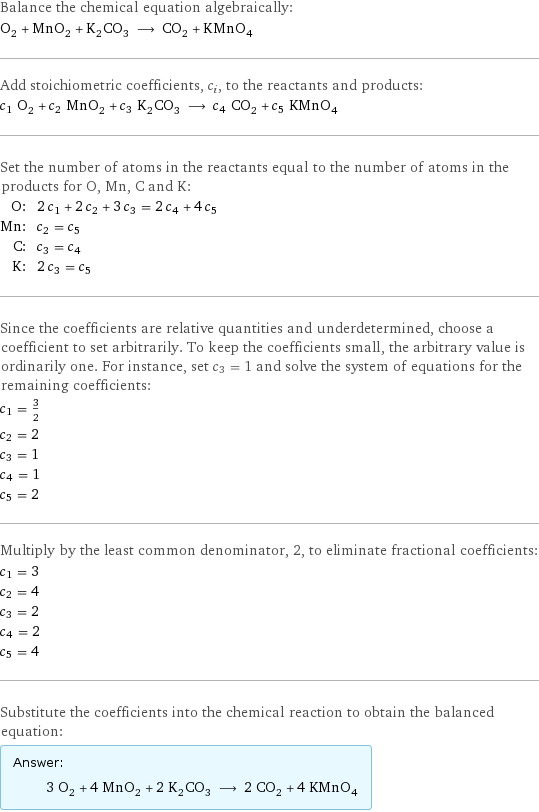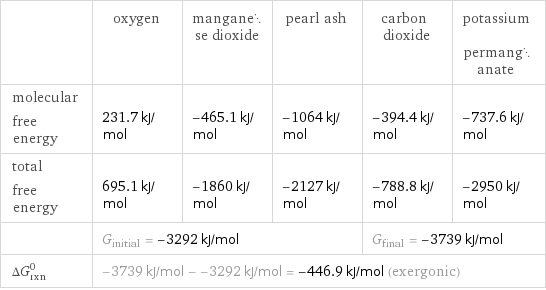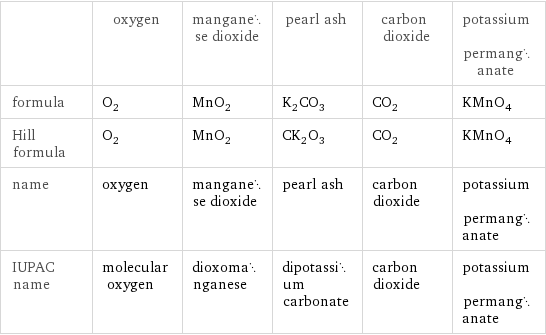Input interpretation

O_2 oxygen + MnO_2 manganese dioxide + K_2CO_3 pearl ash ⟶ CO_2 carbon dioxide + KMnO_4 potassium permanganate
Balanced equation

Balance the chemical equation algebraically: O_2 + MnO_2 + K_2CO_3 ⟶ CO_2 + KMnO_4 Add stoichiometric coefficients, c_i, to the reactants and products: c_1 O_2 + c_2 MnO_2 + c_3 K_2CO_3 ⟶ c_4 CO_2 + c_5 KMnO_4 Set the number of atoms in the reactants equal to the number of atoms in the products for O, Mn, C and K: O: | 2 c_1 + 2 c_2 + 3 c_3 = 2 c_4 + 4 c_5 Mn: | c_2 = c_5 C: | c_3 = c_4 K: | 2 c_3 = c_5 Since the coefficients are relative quantities and underdetermined, choose a coefficient to set arbitrarily. To keep the coefficients small, the arbitrary value is ordinarily one. For instance, set c_3 = 1 and solve the system of equations for the remaining coefficients: c_1 = 3/2 c_2 = 2 c_3 = 1 c_4 = 1 c_5 = 2 Multiply by the least common denominator, 2, to eliminate fractional coefficients: c_1 = 3 c_2 = 4 c_3 = 2 c_4 = 2 c_5 = 4 Substitute the coefficients into the chemical reaction to obtain the balanced equation: Answer: | | 3 O_2 + 4 MnO_2 + 2 K_2CO_3 ⟶ 2 CO_2 + 4 KMnO_4
Structures

+ + ⟶ +
Names

oxygen + manganese dioxide + pearl ash ⟶ carbon dioxide + potassium permanganate
Reaction thermodynamics
Gibbs free energy

| oxygen | manganese dioxide | pearl ash | carbon dioxide | potassium permanganate molecular free energy | 231.7 kJ/mol | -465.1 kJ/mol | -1064 kJ/mol | -394.4 kJ/mol | -737.6 kJ/mol total free energy | 695.1 kJ/mol | -1860 kJ/mol | -2127 kJ/mol | -788.8 kJ/mol | -2950 kJ/mol | G_initial = -3292 kJ/mol | | | G_final = -3739 kJ/mol | ΔG_rxn^0 | -3739 kJ/mol - -3292 kJ/mol = -446.9 kJ/mol (exergonic) | | | |
Equilibrium constant
![Construct the equilibrium constant, K, expression for: O_2 + MnO_2 + K_2CO_3 ⟶ CO_2 + KMnO_4 Plan: • Balance the chemical equation. • Determine the stoichiometric numbers. • Assemble the activity expression for each chemical species. • Use the activity expressions to build the equilibrium constant expression. Write the balanced chemical equation: 3 O_2 + 4 MnO_2 + 2 K_2CO_3 ⟶ 2 CO_2 + 4 KMnO_4 Assign stoichiometric numbers, ν_i, using the stoichiometric coefficients, c_i, from the balanced chemical equation in the following manner: ν_i = -c_i for reactants and ν_i = c_i for products: chemical species | c_i | ν_i O_2 | 3 | -3 MnO_2 | 4 | -4 K_2CO_3 | 2 | -2 CO_2 | 2 | 2 KMnO_4 | 4 | 4 Assemble the activity expressions accounting for the state of matter and ν_i: chemical species | c_i | ν_i | activity expression O_2 | 3 | -3 | ([O2])^(-3) MnO_2 | 4 | -4 | ([MnO2])^(-4) K_2CO_3 | 2 | -2 | ([K2CO3])^(-2) CO_2 | 2 | 2 | ([CO2])^2 KMnO_4 | 4 | 4 | ([KMnO4])^4 The equilibrium constant symbol in the concentration basis is: K_c Mulitply the activity expressions to arrive at the K_c expression: Answer: | | K_c = ([O2])^(-3) ([MnO2])^(-4) ([K2CO3])^(-2) ([CO2])^2 ([KMnO4])^4 = (([CO2])^2 ([KMnO4])^4)/(([O2])^3 ([MnO2])^4 ([K2CO3])^2)](../image_source/b1cccdd0a33b5f649403ea9ccb63afc5.png)
Construct the equilibrium constant, K, expression for: O_2 + MnO_2 + K_2CO_3 ⟶ CO_2 + KMnO_4 Plan: • Balance the chemical equation. • Determine the stoichiometric numbers. • Assemble the activity expression for each chemical species. • Use the activity expressions to build the equilibrium constant expression. Write the balanced chemical equation: 3 O_2 + 4 MnO_2 + 2 K_2CO_3 ⟶ 2 CO_2 + 4 KMnO_4 Assign stoichiometric numbers, ν_i, using the stoichiometric coefficients, c_i, from the balanced chemical equation in the following manner: ν_i = -c_i for reactants and ν_i = c_i for products: chemical species | c_i | ν_i O_2 | 3 | -3 MnO_2 | 4 | -4 K_2CO_3 | 2 | -2 CO_2 | 2 | 2 KMnO_4 | 4 | 4 Assemble the activity expressions accounting for the state of matter and ν_i: chemical species | c_i | ν_i | activity expression O_2 | 3 | -3 | ([O2])^(-3) MnO_2 | 4 | -4 | ([MnO2])^(-4) K_2CO_3 | 2 | -2 | ([K2CO3])^(-2) CO_2 | 2 | 2 | ([CO2])^2 KMnO_4 | 4 | 4 | ([KMnO4])^4 The equilibrium constant symbol in the concentration basis is: K_c Mulitply the activity expressions to arrive at the K_c expression: Answer: | | K_c = ([O2])^(-3) ([MnO2])^(-4) ([K2CO3])^(-2) ([CO2])^2 ([KMnO4])^4 = (([CO2])^2 ([KMnO4])^4)/(([O2])^3 ([MnO2])^4 ([K2CO3])^2)
Rate of reaction
![Construct the rate of reaction expression for: O_2 + MnO_2 + K_2CO_3 ⟶ CO_2 + KMnO_4 Plan: • Balance the chemical equation. • Determine the stoichiometric numbers. • Assemble the rate term for each chemical species. • Write the rate of reaction expression. Write the balanced chemical equation: 3 O_2 + 4 MnO_2 + 2 K_2CO_3 ⟶ 2 CO_2 + 4 KMnO_4 Assign stoichiometric numbers, ν_i, using the stoichiometric coefficients, c_i, from the balanced chemical equation in the following manner: ν_i = -c_i for reactants and ν_i = c_i for products: chemical species | c_i | ν_i O_2 | 3 | -3 MnO_2 | 4 | -4 K_2CO_3 | 2 | -2 CO_2 | 2 | 2 KMnO_4 | 4 | 4 The rate term for each chemical species, B_i, is 1/ν_i(Δ[B_i])/(Δt) where [B_i] is the amount concentration and t is time: chemical species | c_i | ν_i | rate term O_2 | 3 | -3 | -1/3 (Δ[O2])/(Δt) MnO_2 | 4 | -4 | -1/4 (Δ[MnO2])/(Δt) K_2CO_3 | 2 | -2 | -1/2 (Δ[K2CO3])/(Δt) CO_2 | 2 | 2 | 1/2 (Δ[CO2])/(Δt) KMnO_4 | 4 | 4 | 1/4 (Δ[KMnO4])/(Δt) (for infinitesimal rate of change, replace Δ with d) Set the rate terms equal to each other to arrive at the rate expression: Answer: | | rate = -1/3 (Δ[O2])/(Δt) = -1/4 (Δ[MnO2])/(Δt) = -1/2 (Δ[K2CO3])/(Δt) = 1/2 (Δ[CO2])/(Δt) = 1/4 (Δ[KMnO4])/(Δt) (assuming constant volume and no accumulation of intermediates or side products)](../image_source/b441316a70c5398d9bd454f34994b590.png)
Construct the rate of reaction expression for: O_2 + MnO_2 + K_2CO_3 ⟶ CO_2 + KMnO_4 Plan: • Balance the chemical equation. • Determine the stoichiometric numbers. • Assemble the rate term for each chemical species. • Write the rate of reaction expression. Write the balanced chemical equation: 3 O_2 + 4 MnO_2 + 2 K_2CO_3 ⟶ 2 CO_2 + 4 KMnO_4 Assign stoichiometric numbers, ν_i, using the stoichiometric coefficients, c_i, from the balanced chemical equation in the following manner: ν_i = -c_i for reactants and ν_i = c_i for products: chemical species | c_i | ν_i O_2 | 3 | -3 MnO_2 | 4 | -4 K_2CO_3 | 2 | -2 CO_2 | 2 | 2 KMnO_4 | 4 | 4 The rate term for each chemical species, B_i, is 1/ν_i(Δ[B_i])/(Δt) where [B_i] is the amount concentration and t is time: chemical species | c_i | ν_i | rate term O_2 | 3 | -3 | -1/3 (Δ[O2])/(Δt) MnO_2 | 4 | -4 | -1/4 (Δ[MnO2])/(Δt) K_2CO_3 | 2 | -2 | -1/2 (Δ[K2CO3])/(Δt) CO_2 | 2 | 2 | 1/2 (Δ[CO2])/(Δt) KMnO_4 | 4 | 4 | 1/4 (Δ[KMnO4])/(Δt) (for infinitesimal rate of change, replace Δ with d) Set the rate terms equal to each other to arrive at the rate expression: Answer: | | rate = -1/3 (Δ[O2])/(Δt) = -1/4 (Δ[MnO2])/(Δt) = -1/2 (Δ[K2CO3])/(Δt) = 1/2 (Δ[CO2])/(Δt) = 1/4 (Δ[KMnO4])/(Δt) (assuming constant volume and no accumulation of intermediates or side products)
Chemical names and formulas

| oxygen | manganese dioxide | pearl ash | carbon dioxide | potassium permanganate formula | O_2 | MnO_2 | K_2CO_3 | CO_2 | KMnO_4 Hill formula | O_2 | MnO_2 | CK_2O_3 | CO_2 | KMnO_4 name | oxygen | manganese dioxide | pearl ash | carbon dioxide | potassium permanganate IUPAC name | molecular oxygen | dioxomanganese | dipotassium carbonate | carbon dioxide | potassium permanganate
Substance properties

| oxygen | manganese dioxide | pearl ash | carbon dioxide | potassium permanganate molar mass | 31.998 g/mol | 86.936 g/mol | 138.2 g/mol | 44.009 g/mol | 158.03 g/mol phase | gas (at STP) | solid (at STP) | solid (at STP) | gas (at STP) | solid (at STP) melting point | -218 °C | 535 °C | 891 °C | -56.56 °C (at triple point) | 240 °C boiling point | -183 °C | | | -78.5 °C (at sublimation point) | density | 0.001429 g/cm^3 (at 0 °C) | 5.03 g/cm^3 | 2.43 g/cm^3 | 0.00184212 g/cm^3 (at 20 °C) | 1 g/cm^3 solubility in water | | insoluble | soluble | | surface tension | 0.01347 N/m | | | | dynamic viscosity | 2.055×10^-5 Pa s (at 25 °C) | | | 1.491×10^-5 Pa s (at 25 °C) | odor | odorless | | | odorless | odorless
Units
